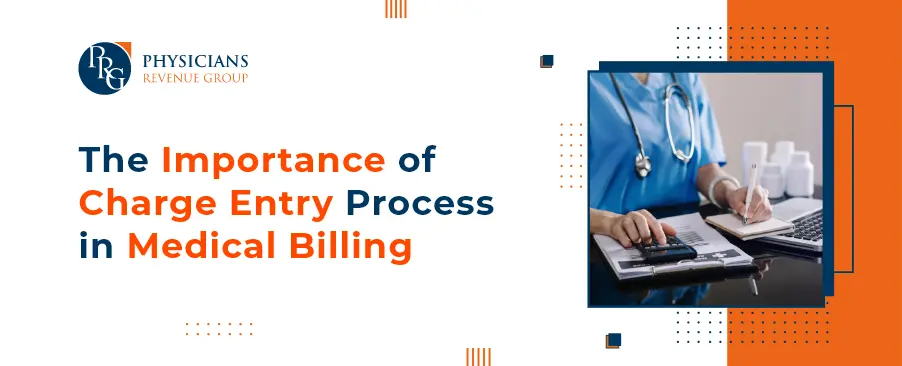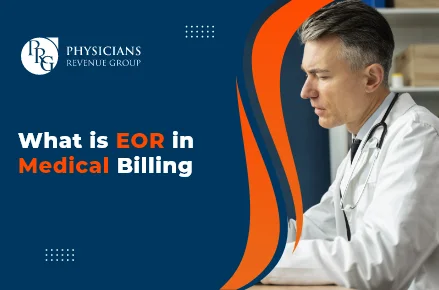
Email: info@prgmd.com | Call: +1 (630) 242-6474
Business hours: 9:00 to 5:00 | Monday to Friday
Email: info@prgmd.com | Call: +1 (630) 242-6474
Business hours: 9:00 to 5:00 | Monday to Friday

Table of Contents
ToggleCorrectly entering each piece of patient and provider’s data is essential during the claim processing. Healthcare providers need specialists to handle the RCM and medical billing services process. Therefore, it is necessary to look for one-stop services that understand the importance of the charge entry process. Each data entered during the process must be accurate, as even a small error can lead to claim denials.
Before going any further, let’s explore:
The charge entry process is vital to effective RCM and billing for medical care providers. The process refers to accurately recording and posting charges for medical procedures and services given to patients.
The initial process starts with the collection of all relevant information. This information relates to the medical services provided – which shall include:
Healthcare practices must ensure that all information entered into the billing systems must be accurate and complete to remove errors. Your billing team must also fully understand the anatomy of a clean claim.
After accurately recording charges, the next step is posting them to the billing system, which leads to submissions to the insurance providers for payment of services. It is essential to ensure that the entire process is completed on time to avoid delays in payments or subsequent claim denials.
Procedural effectiveness, especially in the charge entry process, is essential to the financial success of the healthcare practices. Accuracy in charge entry optimizes the RCM process by extension. Furthermore, implementing the best practices below can help healthcare practices reduce the risk of errors, boost efficiency, and improve overall revenue performance.
According to the medical coding, all patient accounts must have a correct monetary value. Moreover, the reimbursement for services the provider offers patients depends on the proper charge entry process. To that effect, automated coding techniques help avoid errors.
Impact of Incorrect Charge Entry Process
It is essential to optimize the charge entry procedure – owing to its importance for all stakeholders, including the patients, providers, payers, etc. For initial understanding, the charge entry can be a relatively straightforward procedure – comprising of only two steps including:
However, the most impactful and comprehensive charge entry process can be divided into multiple additional steps to meet all stakeholders’ needs.
The first step of the charge entry process is patient registration. It also extends to establishing financial responsibility from the entire billing cycle process. The process includes collecting all required forms relating to patient care and corresponding payments for it – including EOBs (Explanation of Benefits), cash, check, card payments, or any other payment options for due co-pays.
After collecting and receiving all documentation and files, a medical biller must allocate them to the appropriate storage locations compliant with HIPAA. This process leads to further entries and analysis.
The next step of the charge entry process is also the most important. Furthermore, this step is the only one requiring full completion in all cases. The second step of the process corresponds to both steps detailed in the simplified two-step process above.
Ideally, there are two essential categories of details that need entry:
This data is then cross-referenced with medical coding (including modifier coding) for provided care services – to generate accurate costs. It is important to note that a more detailed process helps prevent potential revenue leakage.
For instances where the patients are responsible for some, or for all of the balances due – and there are also some issues like late or missing payments: A provider may investigate the explanation of benefits. This is done to determine the coverage detail, or the lack thereof, to see what further actions are necessary.
Such an investigation may lead to legal actions or negotiations between the stakeholders, including:
In addition to instances where patients neglect partial or complete payments of balances they owe – similar issues may also arise with other payers, including the insurance companies. When this is the case, a process similar to step 3, kicks in; however, the focus here shifts to analyzing a payer’s responsibilities.
Consequently, if rejections and denials are presented to providers, they may indicate issues with medical coding and billing processes. The possible reasons might include incorrect coding or one or two services that might fall outside the spectrum decided by the insurance payers.
An in-detail analysis is essential for recovering reimbursements in such cases.
The last step of the charge entry process is optional, especially for the legal or financial requirements. However, this step is essential for healthcare practices seeking long-lasting and mutually beneficial relationships with patients. Healthcare providers must practice continuity measures, including collecting client feedback and making adjustments when necessary.
Furthermore, if polls, surveys, or patient interviews pinpoint challenges in the data collection process or any other part of the charge entry process, promptly resolving these is necessary. Moreover, taking note of the customer experience in healthcare is also a best practice for facilitating all other steps along the way.
Share:
Categories
Recently Added

What is an ABN in medical billing?

What does a Clearinghouse do During Claims Submission?

What is EOR in Medical Billing?
We Would Love to Assist You!
We treat your data confidentially and don’t share any information with a third party.